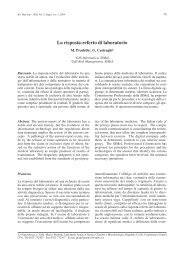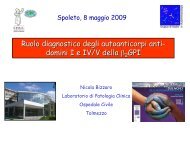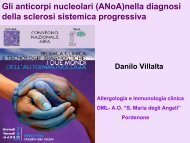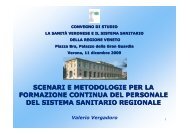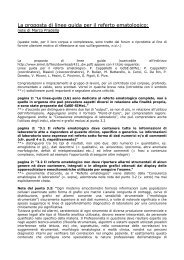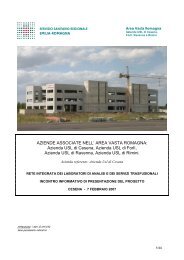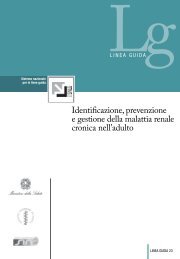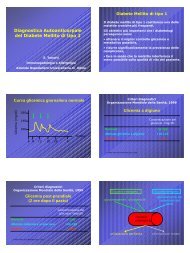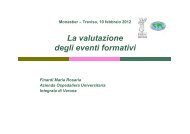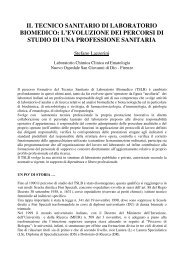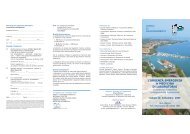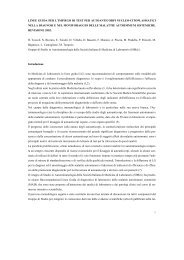TELEMEDICINA, TELEPATOLOGIA, TELELABORATORIO - Simel
TELEMEDICINA, TELEPATOLOGIA, TELELABORATORIO - Simel
TELEMEDICINA, TELEPATOLOGIA, TELELABORATORIO - Simel
Create successful ePaper yourself
Turn your PDF publications into a flip-book with our unique Google optimized e-Paper software.
SIMEL – LAZIOSocietà Italiana Medicina di LaboratorioUSO DELLE NUOVE TECNOLOGIA INFORMATICHE IN PATOLOGIA CLINICAAula Magna P.O. CTO “A. Alesini”05 dicembre 2008<strong>TELEMEDICINA</strong>,<strong>TELEPATOLOGIA</strong>,<strong>TELELABORATORIO</strong>Marco PradellaAsolo
informatica laboratorio medicoriferimentiwww.●●●●●simel.it– GdS Informatica– corso FAD sicurezza ITcismel.itlabmedico.itbitmedicoihe.net
<strong>TELEMEDICINA</strong>, <strong>TELEPATOLOGIA</strong>,<strong>TELELABORATORIO</strong>● Il mercato della tele-sanità● Standard informatici● Esperienze di telepatologia● Tele-medicina low cost● Tele-laboratorio: verifica,correzione, validazione
Domenica 30 Novembre 2008Corriere della Sera
24 ore sanità25 nov.-1 dic. 2008
Teleconsulto Sole 24 Ore 24 nov 08 Qualità
Teleconsulto Sole 24 Ore 24 nov 08 Qualità
www.telemedico.it
corriere.it24 ore sanità
Acting for change: transforming pathology servicesthrough action learningLearning from Phase 2 of thePathology Action LearningProgramme, 2006/08, DH supported some 35 projects around thecountry to improve their local servicesSection 6Laboratory tolaboratorycommunicationshttp://www.networks.nhs.uk/news.php?nid=2450
Acting for change: transforming pathology servicesthrough action learningthe best system to adopt for lab-to-lab communications was theone designed by Dr Rick Jones at Leeds University,...●●●●enables electronic healthcare records, which is a key part ofgovernment policyimproves the diagnostic process by enabling effectivecommunication between laboratories and healthcareprofessionalsincreases accuracy by reducing human input and scope forerrorreduces workloads of laboratory staff●. . .
Acting for change: transforming pathology servicesthrough action learning●●●●allows quick integration of test results into patients’ recordsstreamlines the review and decision-making processfacilitates cumulative reporting, which enables more accurateand timely decision making, andsupports quality assurance, which is currently largely handledmanually.The success of the system is dependent on it being robust andfully supported, with test coding (SNOMED CT) andmessaging standards (HL7) implemented. It also has to bescalable and enable communication with laboratories inScotland, Wales and Northern Ireland too. Funding will alsoneed to be secured.
24 ore sanità25 nov.-1 dic. 2008
<strong>TELEMEDICINA</strong>, <strong>TELEPATOLOGIA</strong>,<strong>TELELABORATORIO</strong>● Il mercato della tele-sanità● Standard informatici● Esperienze di telepatologia● Tele-medicina low cost● Tele-laboratorio: verifica,correzione, validazione
geografia della normazionewww.ANSI.orgISOwww.ASTM.orgwww.ISO.orgUNIwww.CENORM.bewww.UNI.comANSIASTMCEN
ISO/TC 215International Organization for Standardization's (ISO)Technical Committee (TC) on Health informatics.WG 1: Health Records and Modelling CoordinationWG 2: Messaging and communicationsWG 3: Health Concept RepresentationWG 4: SecurityWG 5: Health CardsWG 6: Pharmacy and MedicationWG 7: DevicesWG 8: Business requirements for Electronic Health RecordsWG 9: Joint Initiative on SDO Global Health Informatics Standardization- Joint Working Group (WG9)
CEN TC 251• Working Group I Information Models• Working Group II Terminology andKnowledge Bases• Working Group III Security, Safety andQuality• Working Group IV Technology forInteroperability
European Standards Organizations Launch JointProject on Interoperability of eHealth standards●●●●POSITIVE PROGNOSIS FOR eHEALTH STANDARDIZATIONBrussels (7 February 2008) ... joint project ‘eHEALTH-INTEROP’, ... address therequirements of the European Commission mandate on standardization in the field of e-health. ... (M/403) ...Phase 1, a team of appointed experts reporting to the ESOs will examine the portfolios ofexisting standards from the many different organizations in the sector, including internationalformal bodies and industry standards consortia.Phase 2, in 2009 and 2010, will see the execution of that work program.
... CEN/CENELEC/ETSIM403 – eHealth InteroperabilityOverview of interim draft, and proposed contentMay 28, 2008, Prepared by Melvin Reynolds, Editor for the Project TeameHealth-INTEROP ReportThe project team will bear in mind:●●●●The desire of the Member States to retain their autonomy;The goal of the EC to have joint European/global standardsand to have European policy on eHealth;The consequences for the working methods of the ESOs;The need for use cases, such as the 3 priorities of the EC butalso that emerge from consulting patients, clinicians andhealth authorities.
eHealth-INTEROP Report:Phase 1 Timescale: 1/2●●●.. Wider Co-ordination group in Gothenburg.. 28 May 2008, connected to MIE.. Meeting to discuss the pre-final draft and tomake proposals for amendments●.. July 2008●.. Consultation on the pre-final draft●.. July/August 2008●.. Final phase 1 report and work programmePublic consultation●.. Sept/Oct 2008
eHealth-INTEROP Report:Phase 1 Timescale: 2/2●●●●●.. Public presentation of the report underconsultation Crete.. 9-10 October 2008, connected to IHIC’08.. Open consultation Copenhagen.. 7 November 2008, connected to WoHIT.. Approval of the ESOs of the work programmeand Submission of the phase 1 work programmeto the EC/EFTA●.. Dec 2008
ESO_eHealth-INTEROP_v0500_Summary.docExecutive SummarytoeHealth-INTEROP Reportin response toEU Mandate/403-2007http://www.ehealth-interop.eu
ESO_eHealth-INTEROP_v0500_Summary.docProposals1 Business use case definition andprioritisation2 Base standards development3 Profile development and maintenance4 Profile quality assurance, test plans andtools5 Sharing of best practices in deployingeHealth project
1 Business use casedefinition and prioritisation1.3 Three use cases for public comment1) laboratory enterprise workflow,2) laboratory cross-enterprise informationsharing, and3) for ubiquitous care outside conventionalcare facilities, involving the interoperabilitynecessary from mobile and/or home-basedmonitoring devices
2 Base standardsdevelopment2.1 Resolve inconsistenciesResolve the inconsistencies betweenstandards based on fundamentally differentprinciples (e.g. Electronic Recordsexchange formats using either CEN 13606or HL7 RIM based documents).
5 Sharing of best practices indeploying eHealth projectFor Phase 2 of the eHealth StandardsMandate, It is proposed to rely on theCALLIOPE project to conduct theseactivities for 2009 and 2010. Beyond 2010,a permanent accredited European entityneeds to be designated to conduct theseactivities.
American Telemedicine AssociationStandards Frameworkwww.americantelemed.orgAdministrative StandardsClinical StandardsTechnical Standards
Administrative StandardsOrganizationsHealth ProfessionalsTelemedicine Ethics
prEN 14484 - Health informatics -International transfer of personal healthdata covered by the EU data protectiondirective (July 2003)• 5 The European Data ProtectionDirective (see annex A)– 5.10 Security of processing (Article 17)• 9 High Level Security Policy: thecontent– 9.10 Principle Ten: security of processing
prEN 14484:20039.10 Principle Ten: security of processing• 9.10.3 Principle Ten, Guideline Two:encryption during transmission• 9.10.4 Principle Ten, Guideline Three:proof of data integrity andauthentication of origin• 9.10.5 Principle Ten, Guideline Four:access control and user authentication
prEN 14484:20039.10 decimo principio: sicurezza del trattamentodocumentocifrato“cifrotesto”GL 3documentoleggibileGL 2documentoleggibileGL 4
<strong>TELEMEDICINA</strong>, <strong>TELEPATOLOGIA</strong>,<strong>TELELABORATORIO</strong>● Il mercato della tele-sanità● Standard informatici● Esperienze di telepatologia● Tele-medicina low cost● Tele-laboratorio: verifica,correzione, validazione
Portable telepathology: methodsand toolsLuis Alfaro and Ma José RocaPublished: 15 July 2008Diagnostic Pathology 2008, 3(Suppl 1):S19●●e-mail imageUSB flash drives,
Italian Hospital in Cairo (NPO), CivicoHospital in Palermo, Ospedale S. Giovanni ePaolo Hospital in Venice, Charing CrossHospital in London and the University ofPittsburgh Medical Center Health System(UPMC) in the USATelepathology in emerging countries pilotproject between Italyand EgyptEssam Ayad and Francesco SicurelloPublished: 15 July 2008Diagnostic Pathology 2008, 3(Suppl 1):S2Telepathology is classified into Static,Dynamic, Hybrid and Whole SlideImaging (WSI)
Organizational model for a telepathologysystemRoberto Mencarelli, Adriano Marcolongo and AlessioGasparettoPublished: 15 July 2008Diagnostic Pathology 2008, 3(Suppl 1):S7"hybrid system" composed ofmotorized microscopes, withremote control, and a scannerfor slide digitization
JCAHO REQUIREMENT: Revisionsapproved to telemedicine standardsin “Medical Staff” chapterStandard MS.13.01.012009 standard text:For originating sites only: Licensedindependent practitioners who areresponsible for the care, treatment, andservices of the [patient] via telemedicinelink are subject to the credentialing andprivileging processes of the originating site.www.jointcommission.org
<strong>TELEMEDICINA</strong>, <strong>TELEPATOLOGIA</strong>,<strong>TELELABORATORIO</strong>● Il mercato della tele-sanità● Standard informatici● Esperienze di telepatologia● Tele-medicina low cost● Tele-laboratorio: verifica,correzione, validazione
MIT direttiva 2004 - email• d) efficienza delle amministrazioni: posta elettronica, documento elettronico.– La diffusione della posta elettronica e dell'utilizzo di documentielettronici e' presupposto indispensabile alla migliore efficienzainterna. Ogni amministrazione dovrà, pertanto, dedicarerinnovato impegno a questo tema, realizzando in particolarequanto specificato nella emananda direttiva (casella di postaelettronica in dotazione a tutti i dipendenti, attivazione e utilizzocostante e tempestivo di caselle istituzionali, utilizzo interno dellaposta elettronica almeno in tutti i casi citati, utilizzo di postaelettronica certificata, ecc.).• Il progetto @P@, curato dal CNIPA, rappresenta per tutte le amministrazionistatali il punto di riferimento per ogni iniziativa, sia per quanto riguarda lapartecipazione alle iniziative comuni (posta certificata, indice P.A.), sia per quantoriguarda il sostegno ai progetti specifici di ogni amministrazione.
Capo IVDecreto Legislativo del 7 marzo 2005, n.82Codice dell'amministrazione digitaleTRASMISSIONE INFORMATICA DEI DOCUMENTIArt. 45. Valore giuridico della trasmissione1. I documenti trasmessi da chiunque ad una pubblicaamministrazione con qualsiasi mezzo telematico o informatico,ivi compreso il fax, idoneo ad accertarne la fonte di provenienza,soddisfano il requisito della forma scritta e la loro trasmissione nondeve essere seguita da quella del documento originale.2. Il documento informatico trasmesso per via telematica si intendespedito dal mittente se inviato al proprio gestore, e si intendeconsegnato al destinatario se reso disponibile all'indirizzoelettronico da questi dichiarato, nella casella di posta elettronicadel destinatario messa a disposizione dal gestore.
Decreto Legislativo del 7 marzo 2005, n.82 Codice dell'amministrazione digitaleArt. 47. Trasmissione dei documenti attraverso la posta elettronica tra lepubbliche amministrazioni1. Le comunicazioni di documenti tra le pubbliche amministrazioniavvengono di norma mediante l'utilizzo della posta elettronica; esse sonovalide ai fini del procedimento amministrativo una volta che ne sia verificata la provenienza.2. Ai fini della verifica della provenienza le comunicazioni sono valide se: a) sono sottoscritte con firma digitale o altro tipo difirma elettronica qualificata; b) ovvero sono dotate di protocollo informatizzato; c) ovvero e' comunque possibile accertarnealtrimenti la provenienza, secondo quanto previsto dalla normativa vigente o dalle regole tecniche di cui all'articolo 71; d)ovvero trasmesse attraverso sistemi di posta elettronica certificata di cui al decreto del Presidente della Repubblica 11febbraio 2005, n. 68.3. Entro ventiquattro mesi dalla data di entrata in vigore del presente codice le pubblicheamministrazioni centrali provvedono a:a) istituire almeno una casella di posta elettronica istituzionale eduna casella di posta elettronica certificata ai sensi del decreto delPresidente della Repubblica 11 febbraio 2005, n. 68, per ciascun registrodi protocollo;b) utilizzare la posta elettronica per le comunicazioni tra l'amministrazione ed i propri dipendenti, nel rispetto delle norme inmateria di protezione dei dati personali e previa informativa agli interessati in merito al grado di riservatezza degli strumentiutilizzati.
linee guida postaelettronica in medicina@BEVERLEY KANE, MD, AND DANIEL Z. SANDS,MD, MPH, for the AMIA Internet WorkingGroup, Task Force on Guidelines for the Use ofClinic--Patient Electronic Mail. Guidelinesfor the Clinical Use of ElectronicMail with Patients. Journal of the AmericanMedical Informatics Association, Volume 5, Number 1,Jan/Feb 1998http://www.amia.org/pubs/other/email_guidelines.html
linee guida postaelettronica in medicina@• Electronic Mail -responsabilità condivise• Electronic Mail -responsabilità medico• Electronic Mail -responsabilità paziente
Electronic Mail -responsabilitàcondivise• stabilire scopo scambio email• stabilire tempo di risposta (medico epaziente)• evitare ira, sarcasmo, critiche,riferimenti ironici a terzi• crittografia per proteggere privacy
Electronic Mail -responsabilitàmedicoconsapevolezza paziente elementi sicurezza e riservatezzaconsenso informatoprotezione email posta in arrivo e screensaver con pwnon distribuire indirizzo email a terziusare marchio-firma elettronica e testatina con avviso privacyrisposta automatica per conferma ricezione-letturaallegare stampa email in cartellaback-up settimanalemantenere mailing list per annunci collettivi (problemi tecnici)
Electronic Mail -responsabilitàpazienteclassificare messaggio con oggettousare informazioni identificative(tessera sanitaria, numeroricovero) nel corpousare marchio-firma elettronicacomunicare ricezione dellarisposta del medico
<strong>TELEMEDICINA</strong>, <strong>TELEPATOLOGIA</strong>,<strong>TELELABORATORIO</strong>● Il mercato della tele-sanità● Standard informatici● Esperienze di telepatologia● Tele-medicina low cost● Tele-laboratorio: verifica,correzione, validazione
correzione, verifica e validazionedei risultati• flusso, ciclo, cicli e deragliamenti• verifiche e algoritmi• autoverifica
CAP ChecklistsCOMMISSION ON LABORATORYACCREDITATIONLABORATORY ACCREDITATIONPROGRAM• www.cap.org– The program is based on rigorous accreditation standards that are translatedinto detailed and focused checklist questions. The checklists, which provide aquality practice blueprint for laboratories to follow, are used by the inspectionteams as a guide to assess the overall management and operation of thelaboratory.• “...more than 6,000 laboratories worldwide...”
"alert" or "critical" rangesin (CAP) Checklists• GEN.41320• Does the laboratory have procedures for immediatenotification of a physician (or other clinical personnelresponsible for patient care) when results of certaintests fall within established "alert" or "critical" ranges?– NOTE: This includes results received on specimens sentto reference laboratories for testing. Alert or critical valuesare those results that may require rapid clinical attention toavert significant patient morbidity or mortality. These valuesshould be defined by the laboratory director, in consultationwith the clinicians served.
Validazione >< Verifica• Validation Confirmation, through the provisionof objective evidence, that the requirements for aspecific intended use or application have beenfulfilled. [2]– [2] ISO 8402 (reference only, obsoleted by [8]ANSI/ISO/ASQ Q9000-2000 (U.S. version ISO9000:2000);–http://en.wikipedia.org/wiki/Verification_and_Validation
Validazione >< Verifica• Verification Confirmation, through the provisionof objective evidence, that specified requirementshave been fulfilled. [1]– [1] Quality Management and Quality Assurance -Vocabulary-ISO 8402:1994 (reference only,obsoleted by [8] ANSI/ISO/ASQ Q9000-2000 (U.S.version ISO 9000:2000);
Verifica >
CLSI AUTO10-P Vol. 26 No. 4Autoverification of Clinical Laboratory TestResults; Proposed Guidelineposizione nel flusso
CAP checklists per gestione errori• detect and correct clerical and analytical errors CHM.10800• unusual or inconsistent results MIC.21950 GEN.20364• revised reports, revised and original data, multiple sequential correctionsGEN.41308 GEN.41310 GEN.41312• calculations reviewed GEN.43450• absurd values GEN.43600• specimen quality GEN.43750• result entries verified GEN.43825• results falling outside the AMR limits CHM.15400• who may use the computer system GEN.43150• individuals who have entered and/or modified patient data GEN.43800• technical supervisors GEN.53500• general supervisor GEN.53700• organizational chart GEN.54000• competency of each person GEN.55500• identity of the analyst GEN.41306• 24 hours review CHM.10900• autoverification GEN.43850 GEN.43875 GEN.43878 GEN.43881 GEN.43884GEN.43887 GEN.43890 GEN.43893
Postanalytic (i.e., postexamination)variables(CAP) Checklists• GEN.20364• Are postanalytic variables monitored?• NOTE: Postanalytic (i.e., post-examination) variablesinclude all steps in the overall laboratory process betweencompletion of the analytic phase of testing and results receiptby the requesting physician. Examples are accuracy of datatransmission across electronic interfaces, reflex testing,turnaround time from test completion to chart posting (paperand/or electronic), and interpretability of reports. This list isneither all-inclusive nor exclusive, providing the variableschosen are appropriate to the laboratory's scope of care.
evised reportsin (CAP) Checklists• GEN.41308 Is there a documented system to ensure thatall revised reports for previously reported incorrect(erroneous) patient results are identified as revised,corrected, or amended on all forms of patient reports(paper, video displays, etc.)?– NOTE: ”..., but not minor typographical errors of no clinical consequence.rispostarispostarispostaReports that display revised results must clearly indicate that the new result is achange from a previously reported result.• GEN.41310 When revised results are reported, are therevised and original data clearly identified as such, and arethe original data readily accessible to the user forcomparison?• GEN.41312 When there are multiple sequentialcorrections of a single test result, are all correctionsreferenced in sequential order on subsequent reports?
divisione dei compitidi verifica• analyst performing (stazione analitica) GEN.41306– allarmi strumentali– controllo di qualità interno CQI– limiti di allarme / delta check• technical supervisors (settore) GEN.53500– segnali da AP– risultati complessivi delle serie– VEQ• general supervisor (laboratorio) GEN.53700– segnali da TS– risultati complessivi del paziente– protocolli clinici
24 hours review in(CAP) Checklists• CHM.10900• Are the results of tests performed inthe absence of on-site supervisorsreviewed by the laboratory director orgeneral supervisor within 24 hours?– NOTE: The CAP does NOT requiresupervisory review of all test results. Thisquestion addresses only that situationdefined under CLIA-88 for "highcomplexity testing" performed by trainedhigh school graduates qualified under42CFR493.1489(b)(5) when a qualifiedgeneral supervisor is not present.
Flusso dei risultatiarchivioprelievoverificarisultatoripetizione
<strong>TELEMEDICINA</strong>, <strong>TELEPATOLOGIA</strong>,<strong>TELELABORATORIO</strong>● Il mercato della tele-sanità● Standard informatici● Esperienze di telepatologia● Tele-medicina low cost● Tele-laboratorio: verifica,correzione, validazione
informatica laboratorio medicoriferimentiwww.●●●●●simel.it– GdS Informatica– corso FAD sicurezza ITcismel.itlabmedico.itbitmedicoihe.net



